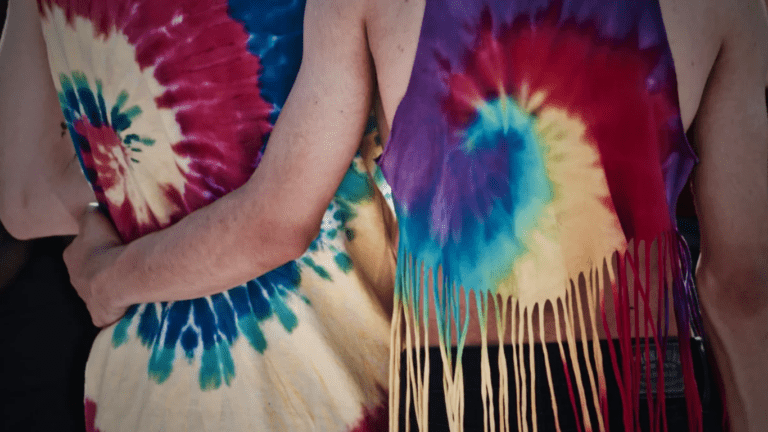
Introduction:
The tie dye era was about brilliant colors self-expression and relaxation. In the 1960s and 1970s tie-dye fashion created waves in clothes and expressed a cultural trend. The top 10 tie-dye styles and their effect on fashion and culture will be examined in this article.
The Origins of Tie-Dye
Tie dye era has a long history before the 1960s and 1970s. Its origins are in ancient cultures worldwide. In ancient Japan, cloth was coiled and bonded before dying to create elaborate patterns like tie-dye. Africa and India have used resist dyeing for ages. Tie-dye became popular in Western fashion during the 1960s counterculture.
The 1960s Counterculture Movement
The 1960s tie-dye boom coincided with the US counterculture. Music art and fashion were popular among young people who rejected conventional ideals. Tie-dye’s brilliant colors and unusual designs embodied individualism and revolt. Janis Joplin and the Grateful Dead wore tie dye era symbolizing the era.
Top 10 Iconic Styles of the Tie-Dye Era
1. Tie-Dye T-Shirts
Probably the most famous tie dye era item the t-shirt was a canvas for self-expression. These homemade shirts showed the wearer’s personality and values via their colors and patterns. DIY allowed people to try numerous styles and color combinations making them attractive. Many people wore tie-dyed t-shirts with spiral or sunburst motifs.
2. Maxi Dresses
Maxi dresses’ flowing shapes suited the tie dye era carefree mood. These colorful tie-dyed gowns were worn at music festivals and informal trips. The enormous length and vibrant colors symbolized the time’s freedom and comfort. These gowns looked more relaxed with platform sandals or boho accessories.
3. Bell-Bottom Pants
Bell-bottom pants were popular during tie dye era. They stood out against the fitting shirts with their flared legs. Popular tie-dyed bell-bottoms let wearers express themselves. These trousers were worn with colorful crop tops or flowing blouses for a boho vibe. Its attire was defined by tie-dye and bell bottoms.
4. Headbands and Accessories
The tie dye era craze included headbands and other accessories. Colorful accessories were popular with men and women for festivals and casual gatherings. Tie-dye headbands gave color to any ensemble and symbolized peace and love. Other tie-dyed accessories like purses and bracelets propagated the trend.
5. Tie-Dye Swimwear
Tie-dye swimsuits became popular in the 1970s as beach culture flourished. Tie-dyed bikinis and one-piece swimsuits let people express themselves in the heat. The colorful colors and patterns made them popular at pools and beaches evoking the era’s carefree mood. Summer perfection was achieved by pairing tie-dye swimsuits with big sunglasses and floppy hats.
6. Tie-Dye Jackets
Tie-dye coats added a distinctive touch to chilly season attire. Denim jackets with multicolored tie-dyes were attractive layering items. These coats might spice up or down clothing. A tie-dye jacket shirt and jeans made a casual yet fashionable appearance. Each piece was unique making them beloved in many wardrobes.
7. Tie-Dye Skirts
Mini to maxi skirts with tie dye era motifs reflected the era’s lively attitude. Tie-dye skirts were lively and balanced with solid-colored tops. The skirts’ fluidity made them ideal for music festival dancing. The flexibility to pair tie-dye skirts with diverse accessories made them popular.
8. Tie-Dye Button-Down Shirts
Button-down shirts especially unisex ones influenced tie-dye. Oversized clothes reflected the casual times. They looked boho when worn open over tank tops or knotted around the waist. Many loved tie-dye button-downs because they could go from casual to formal.
9. Tie-Dye Footwear
Tie-dyed sandals sneakers and clogs were also worn. These bright shoes let people express themselves head-to-toe. Tie-dye shoes and matching clothing evoked the period. Comfortable and attractive tie-dye shoes became a fashion staple.
10. Tie-Dye Home Décor
Tie-dye touched home decor as well as fashion. Brightly colored tie-dye tablecloths drapes and pillow coverings brought the era’s playfulness into homes. Tie-dye became a sign of creativity and self-expression as DIYers personalized their houses. The era’s tie-dyed home decor endured.
The Enduring Legacy of the Tie-Dye Era
Numerous designers and movements were influenced by the tie-dye era. Tie-dye is still used in fashion today. From high-end runways to street-style tie-dye represents uniqueness and inventiveness.
Final Thought:
In conclusion, the tie-dye era was a cultural movement that valued freedom self-expression, and creativity. Tie-dye fashion’s top 10 famous designs show its versatility and significance for a generation. As we appreciate and reinterpret these fashions the tie-dye period lives on.
FAQs:
What is the origin of tie-dye?
Japanese African and Indian cultures used tie-dye processes. American tie-dye evolved in the 1960s alongside the counterculture movement that valued self-expression and uniqueness.
Why did tie-dye become popular in the 1960s and 1970s?
At this time tie-dye was popular among the counterculture. Rebellion inventiveness and free expression were its symbols. Tie-dye symbolized the era’s principles throughout music festivals peace marches and social movements.
What are some iconic tie-dye styles from the era?
Tie-dye t-shirts maxi dresses bell-bottom pants headbands swimsuits jackets skirts button-down shirts footwear and home décor are legendary. Each type has brilliant colors and distinctive patterns to express the wearer’s uniqueness.
How can I incorporate tie-dye into my wardrobe today?
Choose new adaptations of traditional tie-dye clothing to simply include it in your collection. Look for tie-dyed t-shirts dresses and accessories. DIY tie-dye crafts may also make personalized things that match your style.